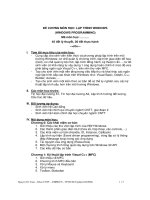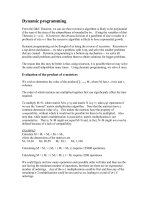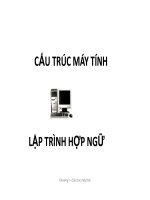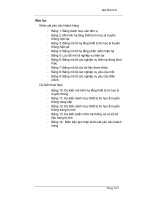Recitation 01 snap py recitation
Bạn đang xem bản rút gọn của tài liệu. Xem và tải ngay bản đầy đủ của tài liệu tại đây (334.45 KB, 30 trang )
Introduction to SNAP.py
CS224W Recitation Session
Alex Haigh
9/28/18
Slides based on 2017’s review session: />
A few notes before we start
1.
These slides (and example code) will be available on Piazza and on
cs224w.stanford.edu
2. SNAP can do even more than what’s described here!
a.
b.
3.
The snap library has many functions not discussed in this deck
Search the SNAP.py documentation before you reinvent the wheel
SNAP is not omnipotent!
a.
b.
For many problems - both in and out of the homework - snap alone is not expressive
enough to do exactly what you need to solve your problem
Sometimes extra data structures are necessary to solve the problem (e.g. maintaining
separate sets of disease IDs and node IDs in HW1 Q4)
Before we begin
•
These slides are available at
/>SNAP.PY_Recitation.pdf
•
All examples used in these slides are available at
/>examples.zip
What is SNAP?
•
Stanford Network Analysis Platform (SNAP) is a general
purpose, high-performance system for analysis and manipulation
of large networks.
•
•
Scales to massive networks with hundreds of millions of
nodes and billions of edges
•
SNAP Software: SNAP.PY for Python, SNAP C++
•
SNAP Datasets: Over 70 datasets, available at http://
snap.stanford.edu/data.
SNAP.PY Resources
•
Prebuilt packages available for Mac OS X, Windows, Linux
•
•
Documentation (including Tutorial & Reference Manual)
•
•
/>
/>
User mailing list
•
/>
SNAP.PY Resources
•
Developer resources (including Benchmarking tools)
•
/>
SNAP Network Datasets
•
Collection of over 70 network datasets
•
/>
Installing SNAP.PY
•
Requires Python 2.7
•
•
Download the SNAP.PY for your platform
•
•
/>
/>
Follow instructions
•
/>
•
(sudo) python setup.py install
Installing SNAP.PY
•
Problems? Refer to our troubleshooting guide
•
/>1iuFKw0mS5GsrVj7T7opXDYqE8fbtd6HTJBZhDYeE3Q/edit
•
Post or look at existing posts on Piazza.
Using SNAP.PY
•
The most important step
•
$ python
>>> import snap
SNAP.PY Tutorial
•
Available on the website
•
•
/>
Today, we will cover
•
Basic SNAP.PY data types
•
Vectors, hash tables and pairs
•
Basic graph types
•
Graph creation
•
Adding and traversing nodes/edges
•
Useful functions for HW0
Basic Types & Vector Types
•
Basic Types in SNAP are TInt, TFlt, and TStr
•
•
Correspond to Python types int, float and str
Vector Types
•
Naming convention: T<value_type>V
•
Examples: TIntV, TFltV, TStrV
•
Operations:
•
Add(<value>): Append a value at the end
•
Len(): Vector size
•
[<index>]: Get or set a value of an existing element
•
for i in V: Iteration over the vector
Vector Example
import snap
v = snap.TIntV()
# Create an empty vector
v.Add(1)
v.Add(2)
v.Add(3)
v.Add(4)
v.Add(5)
# Add elements
print v.Len()
# Print vector size
print v[3]
v[3] = 2*v[2]
print v[3]
# Get & Set elements
for item in v:
print item
# Iterate over elements
for i in range(0, v.Len()):
print i, v[i]
Hash Table Types
•
A set of (key, value) pairs
•
Keys must be of the same type
•
Values must be of the same type
•
However, value type can be different from the key type
•
Naming convention: T<key_type><value_type>H
•
Examples: TIntStrH, TIntFltH, TStrIntH
•
Operations:
•
[<key>]: Add a new value or get or set an existing value
•
Len(): Hash table size
•
for i in H: Iteration over keys
Hash Table Example
import snap
h = snap.TIntStrH()
# Create an empty table
h[5]
h[3]
h[9]
h[6]
h[1]
# Add elements
=
=
=
=
=
'apple'
'tomato'
'orange'
'banana'
'apricot'
print h.Len()
# Print table size
print 'h[3] = ', h[3]
# Get element value
h[3] = 'peach'
print 'h[3] =', h[3]
# Set element value
for key in h:
print key, h[key]
# Iterate over keys
Pair Types
•
A pair (value1, value2)
•
Type of value1 can be different from type of value2
•
Naming convention: T<type1><type2>Pr
•
Examples: TIntStrPr, TIntFltPr, TStrIntPr
•
Operations:
•
GetVal1: Get value1
•
GetVal2: Get value2
Pair Example
import snap
p = snap.TIntStrPr(1, 'one')
# Create a new pair
print p.GetVal1()
print p.GetVal2()
# Get values
Basic Graph Classes
•
Graphs
•
TUNGraph: undirected graph
•
TNGraph: directed graph
•
TNEANet: multigraph with attributes on nodes and edges
Graph (Creation) Example
import snap
''' Graph (Creation) '''
G1 = snap.TNGraph.New()
# Create empty directed graph
G1.AddNode(1)
G1.AddNode(5)
G1.AddNode(12)
# Important: Add nodes before adding edges
G1.AddEdge(1, 5)
G1.AddEdge(5, 1)
G1.AddEdge(5, 12)
# Add edges
G2 = snap.TUNGraph.New()
# Create empty undirected graph
N1 = snap.TNEANet.New()
# Create empty multigraph with attributes
Graph (Traversal) Example
''' Graph (Traversal) '''
for NI in G1.Nodes():
# Node traversal
print 'node id %d, out-degree %d, in-degree %d' % (NI.GetId(), NI.GetOutDeg(),
NI.GetInDeg())
for EI in G1.Edges():
# Edge traversal
print '(%d, %d)' % (EI.GetSrcNId(), EI.GetDstNId())
for NI in G1.Nodes():
# Edge traversal by node
for DstNId in NI.GetOutEdges():
print '(%d, %d)' % (NI.GetId(), DstNId)
Graph (Saving & Loading) Example
''' Graph (Saving & Loading) '''
# Save graph to text file
snap.SaveEdgeList(G1, 'test.txt', 'List of Edges')
# Load graph from text file
G3 = snap.LoadEdgeList(snap.PNGraph, 'test.txt', 0, 1)
# Save graph to binary
FOut = snap.TFOut('test.graph')
G1.Save(FOut)
FOut.Flush()
# Load graph from binary
FIn = snap.TFIn('test.graph')
G4 = snap.TNGraph.Load(FIn)
Loading Text Files
LoadEdgeList(PGraph, InFNm, SrcColId, DstColId, Separator)
G = snap.LoadEdgeList(snap.PNGraph, “wiki-Vote.txt”, 0, 1)
Useful Functions: G.Nodes() & G.Edges()
•
Get a generator for all nodes in graph G
•
•
Get a generator for all edges in graph G
•
•
/>graphs.html?highlight=nodes()
/>graphs.html?highlight=edges()
Example
• for node in G.Nodes()
for edge in G.Edges()
Useful Functions: G.GetNodes() & G.GetEdges()
•
Get the total number of nodes in G
•
•
Get the total number of edges in G
•
•
/>graphs.html?highlight=getnodes
/>graphs.html?highlight=getedges
Example
•
G = snap.LoadEdgeList(snap.PNGraph, "wiki-Vote.txt", 0, 1)
print "G: Nodes %d, Edges %d" % (G.GetNodes(), G.GetEdges())
Useful Functions: CntSelfEdges(G) & CntUniqDirEdges(G)
•
•
Get the total number of self edges in G
•
/>
•
Example
• Count1 = snap.CntSelfEdges(G)
print "Count of self edges is G is %d" % Count1
Get the total number of unique directed edges in G
•
/>
•
Example
•
Count2 = snap.CntUniqDirEdges(G)
print "Count of unique directed edges is %d" % Count2









